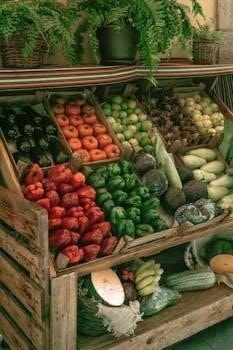Embarking on a journey to learn Spanish opens doors to new culinary experiences, and understanding vegetable names is essential. This knowledge enriches conversations about food and allows for more confident interactions when grocery shopping or dining. Mastering this vocabulary provides a foundational understanding to Spanish.
Importance of Learning Vegetable Names in Spanish
Learning vegetable names in Spanish is crucial for several reasons. Firstly, it greatly enhances your ability to navigate daily life in Spanish-speaking countries. Whether you’re at a local market or a restaurant, knowing the names of vegetables allows you to order food confidently. Secondly, it enriches your conversations about food, a topic that is central to many cultures. Furthermore, understanding these terms lets you explore recipes and culinary traditions, expanding your appreciation of Spanish cuisine. Moreover, it adds depth to your vocabulary, creating opportunities for more nuanced discussions. Being able to describe dishes and ingredients accurately makes your language skills much more practical. This practical knowledge connects you more intimately to Spanish-speaking communities by enabling you to engage in everyday interactions. Lastly, learning these names fosters a greater understanding of cultural aspects related to food. This type of vocabulary is not just about words; it’s about connecting with a new culture and the people who share it.

Common Vegetables and Their Spanish Translations
Exploring the world of vegetables in Spanish reveals a variety of names. This section will introduce you to common vegetables, providing their translations, which are essential for basic communication.
Root Vegetables in Spanish
Root vegetables, often hidden beneath the soil, form a crucial part of many cuisines, and the Spanish language is no exception. Learning their names allows for better communication in markets and restaurants. Some common root vegetables include “zanahoria” (carrot), a staple in many dishes. Then we have “papa” or “patata” (potato) which is incredibly versatile; Don’t forget “remolacha” (beetroot), known for its vibrant color and earthy flavor. “Rábano” (radish), with its peppery bite, is another common example. “Nabo” (turnip) and “jengibre” (ginger) are also essential in various recipes. These form the basis of many meals. Exploring these terms will significantly increase your ability to talk about food in Spanish and understand recipes better.
Leafy Green Vegetables in Spanish
Leafy green vegetables, packed with nutrients, are an essential component of a balanced diet, and their names in Spanish are just as important to know. “Lechuga” (lettuce) is a fundamental salad ingredient and is widely used. Another common leafy green is “espinaca” (spinach), celebrated for its versatility and health benefits. “Acelga” (Swiss chard), is another widely used green in many Spanish recipes. Then we have “col” (cabbage), which comes in various forms and is a staple in many cuisines. “Apio” (celery), which although often used as a stalk, its leaves can also be consumed. Learning these terms helps you understand more about the food you see in markets and on menus, improving your Spanish skills. It also enhances your ability to discuss recipes effectively.
Other Common Vegetables in Spanish
Beyond root and leafy vegetables, there’s a wide array of common vegetables used in Spanish cuisine, each with its unique name. “Tomate” (tomato) is a staple in many dishes, from salads to sauces. “Pepino” (cucumber) is refreshing, commonly used in salads and cold soups. “Pimiento” (pepper), in its many colors, adds a sweet or spicy note. “Calabacín” (zucchini) is quite versatile and shows up in many kinds of preparations. “Berenjena” (eggplant), also known as “aubergine,” is often grilled or fried. “Maíz” (corn) is another common vegetable, often found in soups and stews. “Brócoli” (broccoli) is a popular choice for its health benefits. These examples provide just a glimpse into the rich world of vegetables you will find in Spanish-speaking countries. Knowing these terms makes it easier to navigate menus.

Resources for Learning Spanish Vegetable Vocabulary
Numerous resources are available to aid in learning Spanish vegetable vocabulary, including printable PDF lists, interactive games, and exercises. These tools make language acquisition more engaging and effective for learners.
Printable PDF Lists of Vegetables in Spanish
Printable PDF lists offer a convenient and accessible way to learn Spanish vegetable vocabulary. These lists often categorize vegetables by type, such as root vegetables, leafy greens, and others, making it easier to study. Many resources available online provide comprehensive lists that include both the Spanish and English names, along with images to aid in visual learning and retention. These PDFs can be downloaded and used for self-study or in a classroom setting. Some lists also include example sentences to demonstrate how the words are used in context. Furthermore, some printable lists may offer phonetic pronunciations to help learners with the sounds of the Spanish words. The availability of these resources makes learning Spanish vegetable names more manageable and efficient for all levels of learners.
Interactive Exercises and Games for Learning Vegetables
Interactive exercises and games provide an engaging and effective approach to learning Spanish vegetable vocabulary. These resources often incorporate visuals, audio, and interactive elements to enhance the learning experience. Online platforms offer a variety of activities, such as matching games where learners pair images of vegetables with their Spanish names, crossword puzzles that test vocabulary recall, and fill-in-the-blank exercises that reinforce spelling and usage. Many of these interactive tools also provide immediate feedback, allowing learners to track their progress and identify areas that need more attention. Additionally, some platforms feature pronunciation guides and audio clips to help learners with correct pronunciation. These interactive methods make learning Spanish vocabulary fun and help learners retain the information more effectively than traditional memorization techniques.
Seasonal Vegetables in Spanish
Understanding seasonal availability of vegetables in Spanish-speaking regions is crucial for both language learners and those interested in local cuisine. This knowledge enhances practical usage of vocabulary in daily life.
Understanding Seasonal Availability in Spanish-Speaking Regions
Navigating the world of vegetables in Spanish requires more than just knowing their names; it’s essential to understand their seasonal availability. In Spanish-speaking countries, the freshness and taste of vegetables are often dictated by the time of year. For example, some vegetables may be abundant and affordable during certain seasons, while others are scarce and pricier. This seasonality directly influences local markets and culinary traditions, as well as the cost and quality of food. Many resources highlight monthly guides to seasonal vegetables, which can be incredibly useful when visiting local markets or planning meals using local produce. Knowing when certain vegetables are in season will not only improve your language skills but also enrich your cultural understanding of Spanish-speaking countries, allowing you to savor the freshest flavors and make the most of your grocery shopping experience. It allows a deeper appreciation for food and the environment.

Using Vegetable Vocabulary in Everyday Spanish Conversations
Knowing vegetable names allows you to confidently order food in restaurants or markets. This skill enhances your daily interactions, making conversations more practical and enjoyable. You can engage in simple exchanges about food.
Ordering Vegetables in Spanish Restaurants or Markets
When venturing into Spanish-speaking restaurants or bustling markets, knowing how to order vegetables can greatly enhance your experience. You might want to start with simple phrases like “Quisiera…” (I would like…) followed by the vegetable you desire, for instance, “Quisiera tomates.” If you are unsure, you could ask, “¿Qué verduras tienen?” (What vegetables do you have?). To specify quantities, use “un kilo de…” (a kilo of…) or “una porción de…” (a portion of…). Remember to be polite by using “por favor” (please) and “gracias” (thank you). In a market setting, you might hear “Cuánto cuesta?” (How much does it cost?) or “¿Tiene más?” (Do you have more?). Learning these basic interactions will make your experience much smoother and more enjoyable, allowing you to fully immerse yourself in the local culture and cuisine. Being able to engage in basic transactions like these builds confidence in your language abilities.

Additional Learning Tips
Effective memorization can be achieved through flashcards and regular practice. Labeling kitchen items and speaking Spanish names can reinforce vocabulary. Use real-life situations and don’t be afraid to ask for help.
Tips for Memorizing Vegetable Names in Spanish
Memorizing new vocabulary, especially vegetable names in Spanish, can be made easier with a few effective techniques. Firstly, creating flashcards with the Spanish word on one side and the image or English equivalent on the other is a great visual aid. Regular review of these flashcards will help reinforce the words in your memory. Another helpful tip is to label items in your kitchen with their Spanish names, so you see them daily. This kind of constant exposure is helpful. Engage all of your senses by saying the Spanish words aloud while touching, smelling, or even tasting the vegetables. Also, using the vegetable names in everyday conversations, perhaps when ordering or shopping. Don’t be afraid to use the new words even if you are unsure. Don’t be afraid to ask a native speaker for help. Making mistakes is part of learning. Practice regularly; it’s better to practice a little every day than a lot one day. Using online games and quizzes can also be a fun way to test yourself and see your progress.

